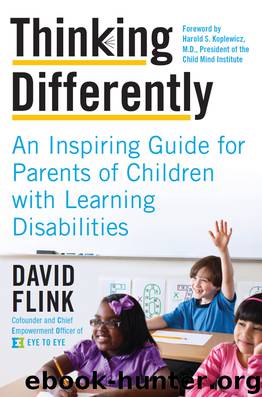Thinking Differently by David Flink

Author:David Flink
Language: eng
Format: epub
Publisher: HarperCollins
Chapter 6
WORK SMARTER
One reason I have confidence in my writing is I have confidence in my stamina.
—John Irving, author, dyslexic
Many kids with LD/ADHD want nothing more than to excel. They simply don’t know how. Schools assume that everyone knows how to work hard and that if you do, success will follow.
Unfortunately, we all know this is not always the case. As parents, you may need to help your child discover what it means to work smarter—by knowing how her brain works and using her accommodations—to bring her closer to her goals.
Take the Chairlift When You Can
When I decided to get my master’s in education, I chose Columbia’s dis/Abilities Studies Program for a variety of reasons, not the least of which was the defiant way they spelled dis/Ability. My hope was to find a group of like-minded people interested in exploring the state of education; specifically, what was disenfranchising smart students in our schools at an alarming rate.
With that lofty goal in mind, I set off for northern Manhattan every morning from my Brooklyn apartment. It was a long train ride, and I made sure to use the time wisely, working on reading assignments and doing my best to stay ahead of my classes. The good news was that I no longer faced a stream of distractions as I had in college—no late-night pizza parties, no noisy friends stumbling into my room to pull me away from the reading that took me twice as long to finish anyway.
As with most schools of higher learning, Columbia did things in a very specific—and very traditional—way. Despite the fact that I was in a program progressively titled dis/Ability Studies, in order to pass my classes, I was still expected to read, write papers, and take tests. Although I had mastered that way, I knew it wasn’t the best way for me to learn because it took so much extra effort. It didn’t actually deepen my learning.
It was as if I was at a great ski resort whose tradition maintained that skiers walked up the hill, and everyone obliged. I wanted to take a chairlift. Walking would have been harder, not smarter, because the goal was skiing, not walking up the hill. At Columbia, my goal was to learn, not to trudge up a hill to get to learn. I loved learning and knew I could do it the hard way—by walking up the hill—or the better way, by taking the chairlift. For me, that meant learning interactively with teachers who would challenge and engage me.
One reason I chose Columbia was that the authors of the textbooks we used in the classroom were actually on the faculty. As much as I could, I tried to enroll in classes taught by teachers I’d have face-to-face access to. I ignored “tradition” and the read/study/write paradigm and jumped on the chairlift as much as possible.
To me, the most compelling professor at Columbia—perhaps the single biggest draw to me as a student—was a woman named Maxine Greene. I’d been reading her work since I was eighteen and couldn’t wait to study under her.
Download
This site does not store any files on its server. We only index and link to content provided by other sites. Please contact the content providers to delete copyright contents if any and email us, we'll remove relevant links or contents immediately.
The Art of Coaching Workbook by Elena Aguilar(50121)
Trainspotting by Irvine Welsh(21038)
Twilight of the Idols With the Antichrist and Ecce Homo by Friedrich Nietzsche(18305)
Fangirl by Rainbow Rowell(8798)
Periodization Training for Sports by Tudor Bompa(7929)
Change Your Questions, Change Your Life by Marilee Adams(7384)
This Is How You Lose Her by Junot Diaz(6452)
Asking the Right Questions: A Guide to Critical Thinking by M. Neil Browne & Stuart M. Keeley(5360)
Grit by Angela Duckworth(5302)
Red Sparrow by Jason Matthews(5200)
Paper Towns by Green John(4805)
Room 212 by Kate Stewart(4741)
Ken Follett - World without end by Ken Follett(4449)
The Sports Rules Book by Human Kinetics(4079)
Housekeeping by Marilynne Robinson(4070)
Double Down (Diary of a Wimpy Kid Book 11) by Jeff Kinney(3935)
Papillon (English) by Henri Charrière(3914)
The Motorcycle Diaries by Ernesto Che Guevara(3790)
Exercise Technique Manual for Resistance Training by National Strength & Conditioning Association(3790)
